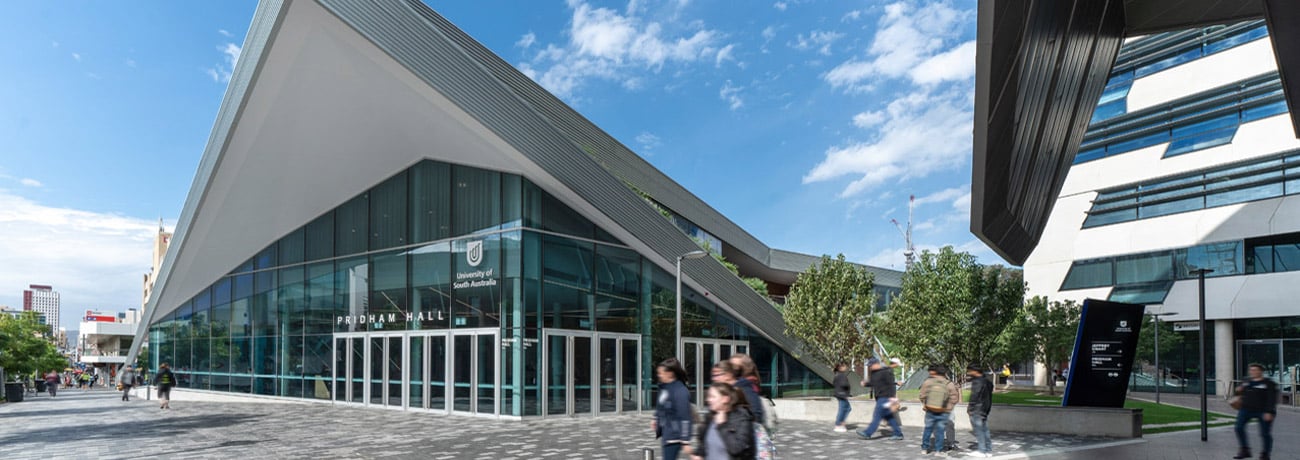

Applicants are required to meet one of the following criteria with a competitive result, and demonstrate that they fulfil any prerequisite requirements and essential requirements for admission:
Recent secondary education:
Meet any prerequisite requirements with a minimum grade of C- or equivalent and
Complete secondary qualifications equivalent to SACE, or
Complete the International Baccalaureate Diploma with a minimum score of 24 points
or
Higher education study
Complete or partly complete a recognized higher education program at a recognized higher education institution
or
Vocational Education and Training (VET)
Complete an award from a registered training organisation at Advanced Diploma level or above
or
Work and life experience
Hold completed secondary qualifications equivalent to SACE obtained more than 2 years in the past
English language requirements:
IELTS score of 7.0; TOEFL iBT score of 94 with no band less than 22; TOEFL paper-based test (PBT) score of 600 with TWE of 5.0; Cambridge CAE/CPE score of 186; Pearson's test of English (Academic) (PTE) score of 65 with no communicative score less than 65; CELUSA score of AE6.
Medical imaging professionals (diagnostic radiographers) are responsible for producing high quality medical images using various technologies and types of radiation to monitor and diagnose injuries and illnesses. Their work includes general radiography such as x-rays, fluoroscopy, theatre or emergency imaging.
As a medical imaging student, you will learn in fully functioning x-ray suites on-campus, where you’ll gain valuable hands-on experience. Further practical experience is gained during more than 1,400 hours of clinical placements, complemented by an in-depth theoretical component taught by our award-winning teachers.
With a suite of state-of-the-art imaging facilities located on-campus, it’s easy to see why this degree is so highly regarded both nationally and internationally.
High achieving students may be considered for the Bachelor of Medical Radiation Science (Honours) (Medical Imaging) program in the third year.
What you'll learn
Throughout your degree you will learn how to produce optimal images, which involves using complex equipment whilst caring for patients and working across a variety of locations.
During your first year you will focus on basic sciences at the core of the study and practice of medical radiation science. You will cover a range of topics, including anatomy, physiology, pathology and radiation physics. These core subjects offer an introduction to medical radiation and the scientific principles surrounding it.
Applying these concepts to professional practice occurs through clinical placements, which begin in your second year and continue through third and fourth year.
Throughout your degree you will take part in regular pre-clinical preparation workshops to further extend your skills as you move into advanced areas of practice.
Your career
In Australia, growth for medical radiation science professionals has been on the rise with career prospects continuing to look very strong, with an expected 11,000 job openings over the next five years.1 You should enjoy working with people, with technology, helping sick or injured people, working a variety of hours, be interested in the human body, being challenged by new ideas and being part of a team.
Medical imaging professionals work in a variety of settings, including:
hospitals
private practices
the Defence Force
medical equipment companies
research and development.
You may also gain employment in specialist areas such as:
ultrasound: produce detailed images of the body in real time to diagnose and monitor a range of health conditions
interventional: medical imaging technique used to visualise blood vessels
magnetic resonance imaging: operate MRI scanners to create 3D images of a patient’s body tissues, which are then used to diagnose illness and disease
computed tomography: operate CT equipment to produce cross-sectional images of a patient’s bones, organs and tissues.
Level of Study: Bachelor Degree
Duration: 4 years
CRICOS Course Code: 088578G
English Requirements: IELTS Score UG 7
Annual Tuition: AUD$41,700.00
Disclaimer: The listings provided on the StudyAdelaide.com website are for information and promotional purposes only. The information, content and material provided in the listings is the sole responsibility of each education provider. While every care has been taken in preparing the information published on this website, StudyAdelaide does not guarantee the accuracy or currency of the content.